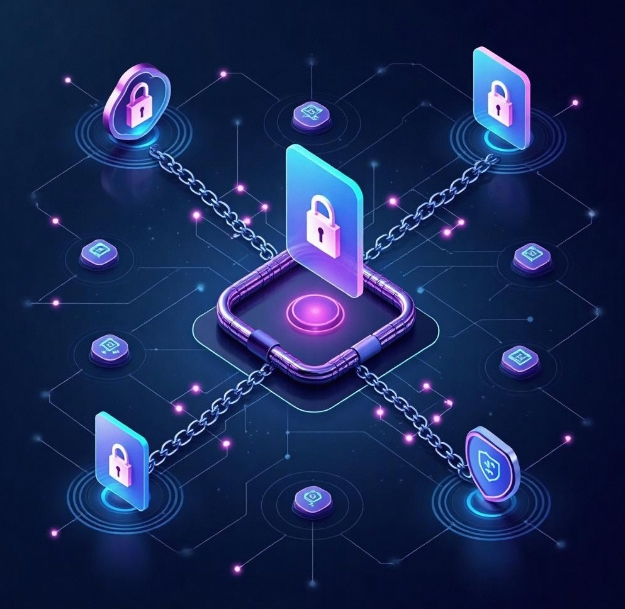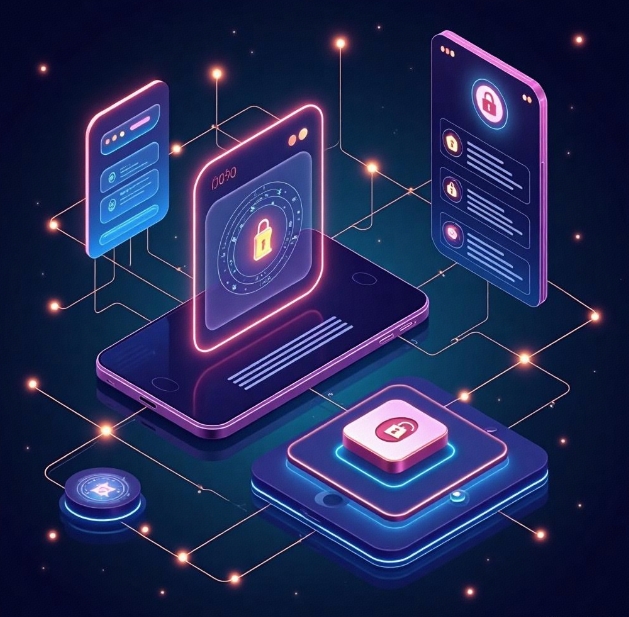How to Ensure the Security of User Assets and Data in DApp Development?
- latest articles
- 1.DApp Development & Customization: Merging Diverse Market Needs with User Experience 2.Analysis of the Core Technical System in DApp Project Development 3.How to achieve cross-chain interoperability in Web3 projects? 4.How does the tokenization of points reconstruct the e-commerce ecosystem? 5.How to Set and Track Data Metrics for a Points Mall? 6.What is DApp Development? Core Concepts and Technical Analysis 7.Inventory of commonly used Web3 development tools and usage tips 8.Development of a Distribution System Integrated with Social E-commerce 9.Six Key Steps for Businesses to Build a Points Mall System 10.What is DApp Development? A Comprehensive Guide from Concept to Implementation
- Popular Articles
- 1.Future Trends and Technology Predictions for APP Development in 2025 2.Analysis of the DeFi Ecosystem: How Developers Can Participate in Decentralized Finance Innovation 3.From Zero to One: How PI Mall Revolutionizes the Traditional E-commerce Model 4.DAPP Development | Best Practices for Professional Customization and Rapid Launch 5.Recommended by the Web3 developer community: the most noteworthy forums and resources 6.From Cloud Computing to Computing Power Leasing: Building a Flexible and Scalable Computing Resource Platform 7.How to Develop a Successful Douyin Mini Program: Technical Architecture and Best Practices 8.Shared Bike System APP: The Convenient Choice in the Era of Smart Travel 9.How to Create a Successful Dating App: From Needs Analysis to User Experience Design 10.From Design to Development: The Complete Process of Bringing an APP Idea to Life
With the continuous development of blockchain technology, decentralized applications (DApps) have gradually entered the public's view. Leveraging the decentralized nature of blockchain, DApps can provide users with more transparent, secure, and trustworthy services. However, despite the inherent security advantages of blockchain, DApp developers still face numerous security challenges, especially in safeguarding user assets and data security. This article will start with the basic concepts of DApps, analyze the potential security issues in current DApp development, and propose effective security measures, aiming to provide valuable security recommendations for DApp developers.
I. Basic Concepts and Characteristics of DApps
DApps are decentralized applications that run on the blockchain. Unlike traditional applications, they typically consist of smart contracts and a front-end interface. Smart contracts are self-executing computer programs on the blockchain, characterized by being public, transparent, and immutable. Users interact with smart contracts through the DApp's front-end interface, while all data and transaction records are stored and verified via the blockchain.
Compared to traditional applications, the greatest advantage of DApps lies in their decentralization. The decentralized architecture eliminates reliance on a single server or third-party platform, instead ensuring data security and immutability through the blockchain's consensus mechanism. This characteristic gives DApps unparalleled advantages in data privacy, transparency, and censorship resistance over traditional applications.
However, decentralization also introduces new security challenges. Since DApps often involve the transfer and management of user assets, security vulnerabilities can lead to significant losses of user funds and data. Therefore, ensuring the security of user assets and data privacy during DApp development has become a critical issue that developers must prioritize.
II. Major Security Risks in DApp Development
During DApp development, risks related to asset and data security mainly include the following aspects:
1. Smart Contract Vulnerabilities
Smart contracts are the core components of DApps, but the code of smart contracts may contain potential security vulnerabilities. For example, coding errors, logic flaws, and reentrancy attacks can cause smart contracts to fail to execute as intended, or even allow attackers to maliciously manipulate funds within the contract.
Common smart contract vulnerabilities include:
Reentrancy Attacks: Attackers call external functions within the contract, causing the contract to repeatedly execute before completing the current transaction, resulting in fund theft.
Integer Overflow and Underflow: Numerical calculations in smart contracts may experience overflow or underflow issues, leading to unpredictable contract behavior.
Authorization Vulnerabilities: If smart contracts lack proper permission controls, attackers may exploit permission vulnerabilities for malicious operations.
Timestamp Dependency Vulnerabilities: Over-reliance on block timestamps in smart contracts may lead to abnormal contract behavior, which attackers can exploit for manipulation.
2. User Private Key Leakage
Users in DApps manage their assets through digital wallets (such as MetaMask). The private key of a digital wallet is the sole credential for user assets; once leaked, attackers can easily steal the user's assets.
User private key leakage can occur for various reasons, including:
Improper User Operations: For example, users entering private keys in insecure environments or storing private keys in unsafe locations.
Malware Attacks: For example, stealing user private keys through trojans or other malicious software.
Phishing Attacks: Attackers trick users into entering private keys or seed phrases by impersonating wallet websites or applications.
3. Front-End Security Issues
The front-end interface of a DApp interacts with smart contracts through libraries like Web3.js, making the front-end a potential attack surface. Hackers may use methods such as XSS (Cross-Site Scripting) and CSRF (Cross-Site Request Forgery) to obtain sensitive user information or tamper with user requests, thereby achieving asset theft.
4. Blockchain Network Attacks
Although blockchain technology itself is highly secure, blockchain networks can still be attacked. For example, a 51% attack can disrupt the blockchain's consensus mechanism, allowing attackers to modify transaction history or perform double-spending. Additionally, DApp smart contracts rely on the stability of the blockchain network; network issues can affect the execution results of contracts.
III. Measures to Safeguard User Assets and Data Security
To ensure the security of user assets and data, DApp developers should adopt multiple security measures to ensure the robustness and reliability of the application.
1. Secure Smart Contract Development
When writing smart contracts, developers should follow secure development practices and conduct rigorous audits. Specific measures include:
Using Secure Development Frameworks: Developers can choose verified smart contract development frameworks, such as OpenZeppelin, which provide audited secure contract templates, reducing errors during development.
Code Auditing: Smart contract code should be audited by third-party security companies to identify potential security vulnerabilities and risks.
Multi-Signature and Permission Controls: For high-risk operations, developers should implement multi-signature mechanisms to ensure decentralized operational permissions and avoid single points of failure.
Limiting Contract Functionality: Smart contracts should avoid overly complex functionalities to prevent introducing unnecessary security risks.
2. User Private Key Management and Protection
To protect user private keys, DApp developers can take the following measures:
Enforcing Multi-Factor Authentication: DApps should require users to enable multi-factor authentication (e.g., SMS verification codes, email verification) to enhance security.
Encrypted Private Key Storage: User private keys should be stored using encryption technology to avoid plaintext storage or leakage.
Avoid Storing Private Keys on the Client Side: DApp front-ends should not store private keys; user private keys should only be kept in local secure environments (e.g., hardware wallets, encrypted storage devices).
3. Front-End Security Protection
The front-end is a crucial interaction window for DApps; developers need to enhance front-end security to prevent attacks such as XSS and CSRF. Specific measures include:
Input Validation and Sanitization: Developers should strictly validate and sanitize user inputs in front-end input fields to prevent malicious script injection.
Using Content Security Policy (CSP): By setting CSP, restrict the loading of external scripts to reduce the risk of XSS attacks.
Strengthening Cross-Site Request Protection: To prevent CSRF attacks, developers can verify the origin of user requests to ensure their legitimacy.
4. Blockchain Network and Data Security
At the blockchain level, developers should focus on the following aspects:
Adopting Mature Blockchain Platforms: Choose widely validated and highly secure blockchain platforms (such as Ethereum, Polkadot) for deploying DApps.
Considering Network Security: DApp developers should pay attention to the stability of the blockchain network and avoid using consensus mechanisms that are prone to attacks.
Regular Updates and Monitoring: DApp smart contracts and front-ends should be regularly updated to fix known vulnerabilities, and real-time security monitoring should be conducted to prevent attacks.
IV. Conclusion
In the development process of DApps, safeguarding user assets and data security is of paramount importance. As technology continues to advance, blockchain and decentralized applications will become more mature and widespread. However, security issues will also become a bottleneck restricting the development of DApps. Therefore, DApp developers need to strengthen security protections during development, conduct rigorous code audits and compliance checks, and adopt best security practices to ensure the security of user assets and data. Only in this way can DApps gain user trust and widespread adoption globally.
-

DApp Development & Customization: Merging Diverse Market Needs with User Experience
As blockchain technology matures and becomes more widespread, decentralized appl···
-

Analysis of the Core Technical System in DApp Project Development
With the rapid development of blockchain technology, decentralized applications ···
-

What is DApp Development? Core Concepts and Technical Analysis
With the rapid development of blockchain technology, decentralized applications ···

 Blockchain
Blockchain












